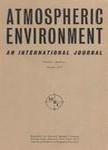版权所有:内蒙古大学图书馆 技术提供:维普资讯• 智图
内蒙古自治区呼和浩特市赛罕区大学西街235号 邮编: 010021

作者机构:Univ Calif Irvine Program Publ Hlth Coll Hlth Sci Irvine CA 92697 USA Chinese Acad Sci State Key Lab Resources & Environm Informat Syst Inst Geog Sci & Nat Resources Res Beijing 100864 Peoples R China Univ Calif Los Angeles Sch Publ Hlth Dept Epidemiol Los Angeles CA 90024 USA
出 版 物:《ATMOSPHERIC ENVIRONMENT》 (大气环境)
年 卷 期:2012年第55卷
页 面:220-228页
核心收录:
学科分类:0830[工学-环境科学与工程(可授工学、理学、农学学位)] 08[工学] 0706[理学-大气科学]
基 金:National Institute of Environmental Health Sciences [NIEHS R21ES016379] Health Effect Institute [HEI 4787-RFA09-4110-3 WU] California Air Resources Board [04-323]
主 题:Land-use regression Spatial residuals Generalized additive model Cokriging Traffic air pollution
摘 要:Land-use regression (LUR) models have been developed to estimate spatial distributions of traffic-related pollutants. Several studies have examined spatial autocorrelation among residuals in LUR models, but few utilized spatial residual information in model prediction, or examined the impact of modeling methods, monitoring site selection, or traffic data quality on LUR performance. This study aims to improve spatial models for traffic-related pollutants using generalized additive models (GAM) combined with cokriging of spatial residuals. Specifically, we developed spatial models for nitrogen dioxide (NO2) and nitrogen oxides (NOx) concentrations in Southern California separately for two seasons (summer and winter) based on over 240 sampling locations. Pollutant concentrations were disaggregated into three components: local means, spatial residuals, and normal random residuals. Local means were modeled by GAM. Spatial residuals were cokriged with global residuals at nearby sampling locations that were spatially auto-correlated. We compared this two-stage approach with four commonly-used spatial models: universal kriging, multiple linear LUR and GAM with and without a spatial smoothing term. Leave-one-out cross validation was conducted for model validation and comparison purposes. The results show that our GAM plus cokriging models predicted summer and winter NO2 and NOx concentration surfaces well, with cross validation R-2 values ranging from 0.88 to 0.92. While local covariates accounted for partial variance of the measured NO2 and NOx concentrations, spatial autocorrelation accounted for about 20% of the variance. Our spatial GAM model improved R-2 considerably compared to the other four approaches. Conclusively, our two-stage model captured summer and winter differences in NO2 and NOx spatial distributions in Southern California well. When sampling location selection cannot be optimized for the intended model and fewer covariates are available as predictors for t